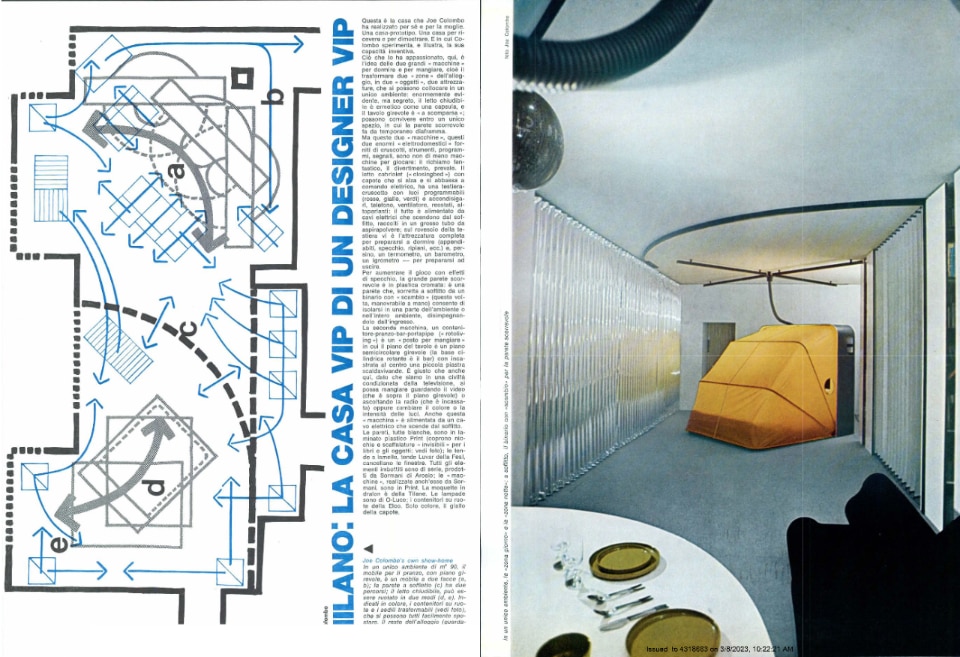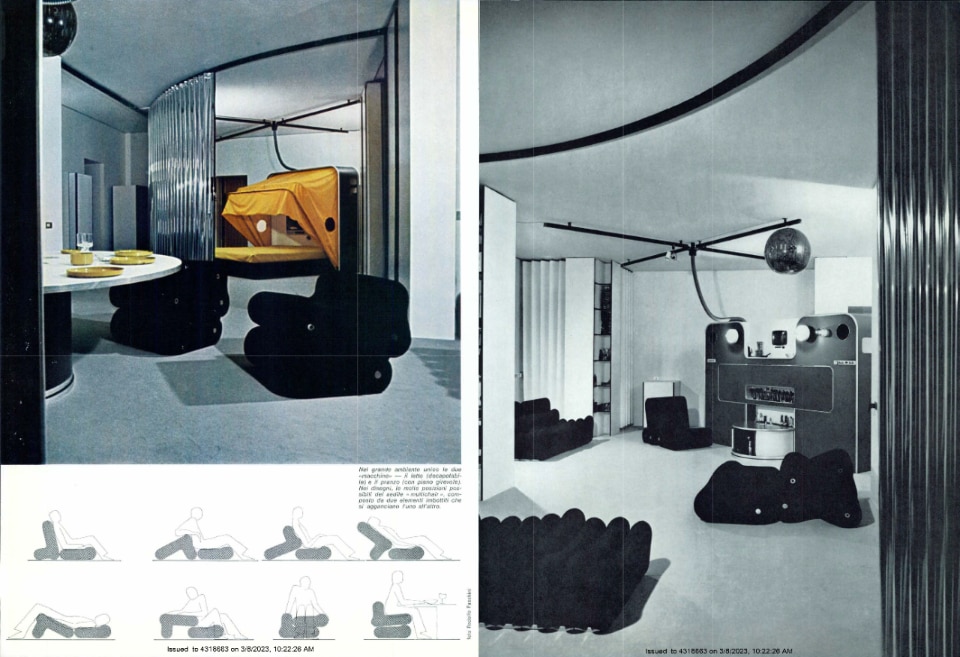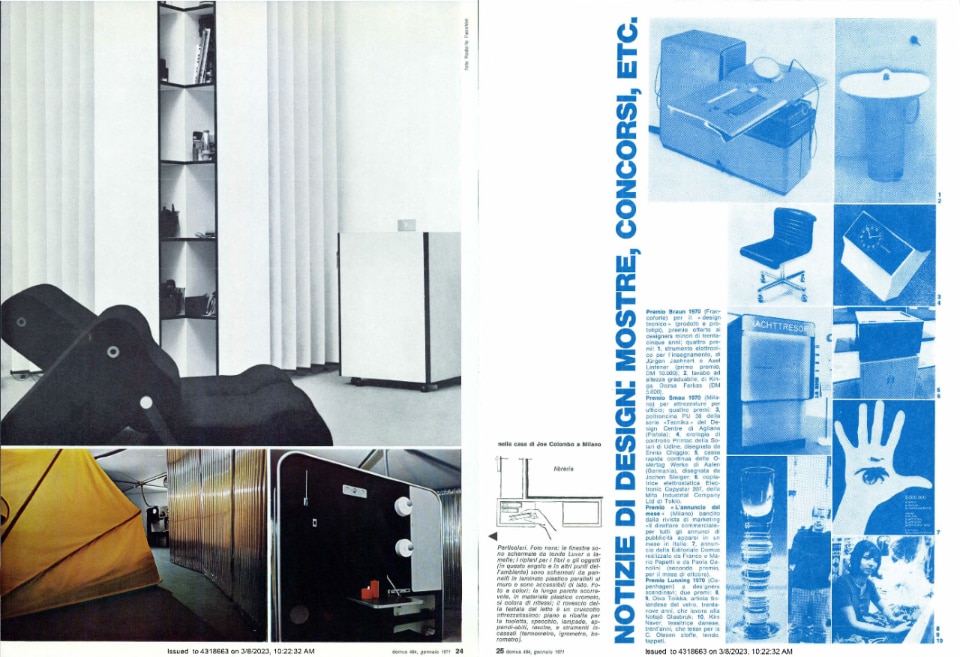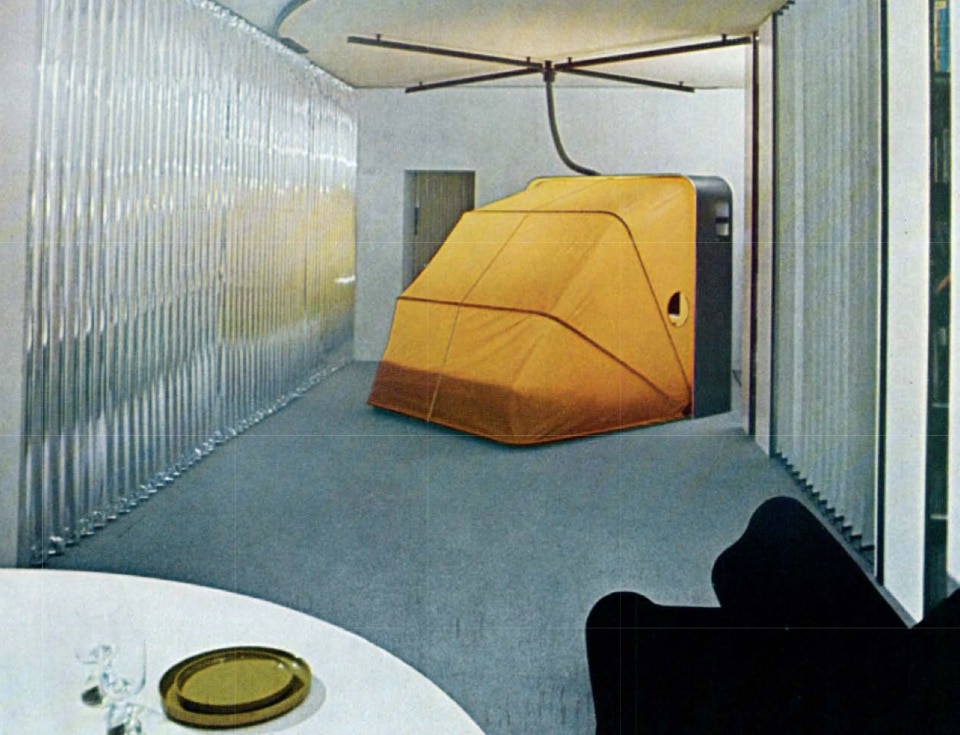In the late 1960s, Finnish designer Matti Suuronen marketed his prototype for a prefabricated house, the Futuro House or Futuro Pod. A futuristic dwelling in the shape of a flying saucer, with a eight-metre diameter. The concept was representative of how people looked to Space (or, better, to its television and film transpositions) to envision the living environments of tomorrow.
In January 1971, Domus 494 published the project of a flat that was a direct consequence of the same mindset. “Milan: the VIP home of a VIP designer”, a reportage into the home designed by Joe Colombo for himself. “A prototype home. A home to host and to show off. And in which Colombo experiments, and applies, his inventive skills.”
The environment, Domus notes, pursues secrecy while relying on a surface that is anything but intimate. For example, “The folding bed is as hermetic as a capsule, and the swivelling table is concealed”.

The flat looks abstracted from the wider city context of the city, as to reach for an extra-terrestrial iconographic discourse that reinforces the capsule concept. As a matter of fact Colombo employs Luvar curtains to “conceal the windows” and covers the whole surface with white laminate by Print. Similarly, bookcases and shelves carved into the walls are screened by parallel plastic laminate panels, accessible from the side.
The ephemeral dimension of the room is enhanced by a sliding partition in chrome-plated plastic that separates, according to one’s living needs, the sleeping area from the kitchen area. These two spaces are seen by Domus as “machines” that transform the “two areas of the flat into two objects”.
The project’s distinctive modularity is also an exercise in design innovation to exploit the property’s 90 square metre surface at its best. Such an attitude is mirrored in the second of the “machines”, a “lunch box-bar-pipe rack (rotoliving)”. It has to be thought of more as a command station and “place to eat” than as a real kitchen, this to emphasise the idea born in those years of food as a fast, utilitarian and systemic process. A direct consequence, one may argue, of consumerist culture and of the first supermarkets.
This is underlined by the “small electric hob” set into the semi-circular surface of the table, resting on a rotating base that serves as a bar.

Underlining the domestic versatility pursued by Colombo, trolleys with wheels (a signature feature of the designer, along with the house’s OLuce lamps) and “multichair” seatings which, as Domus illustrates, can be arranged in six different ways, and used both as chairs for eating and as reclining armchairs on which to rest.
Joe Colombo’s project finds a backdrop in the popular culture of the time, especially in cinema, where white-surfaced flats designed using a modular approach incarnate the updated iconography of the Italian domestic status quo. They incarnate sophistication (The Pacifist) but are equally adopted to reaffirm the bourgeois grandeur (Dismissed On His Wedding Night); they touch upon sci-fi op-art (The Tenth Victim) and eventually reach hyperbolic traits in the house of Monica Vitti and Giorgio Albertazzi in I Married You For Fun and – even more – in Renato Pozzetto’s uber-modular one-room apartment in Il Ragazzo di Campagna.
This reminds us how, between the Sixties and Seventies, the theme of the ephemeral also unfolded through a certain light-heartedness in living, which can be traced in the playful dimension of the home. The outcome was a rise in the synergy established between design and the development of electronics. Hence, the “hermetic” character of the bed simultaneously gives way to that of “fun, which prevails”.
“The cabriolet bed with a convertible top that raises and lowers electronically, features a headboard-dashboard with programmable lights (red, yellow, green) and cigar lighter, telephone, fan, rheostats; everything is connected by electric cables that descend from the ceiling, collected in a large hoover tube”.

The will to explore the realm of furniture design with a dash of playfulness also characterises another classic of Colombo’s, the CANDYzionatore air conditioner, winner of the Compasso d’Oro in 1970.
Then, there is the theme of the media, here faced by Colombo at a time in history when the TV set has become the secular totem of domestic life. “It is right that here too, since we are in a civilisation conditioned by television, we can eat while watching the video, listening to the radio, or changing the colour and intensity of the lights”.
Colombo thus seems to anticipate “La Casa Telematica”, an installation by Ugo la Pietra with Gianfranco Bettetini and Aldo Grasso at the 1983 Milan Fair, “an experiment in observation and contamination between the growing electronic memory and domestic space.”
Opening image: detail of Joe Colombo’s own show-home. Photo: Domus 494, January 1971.


